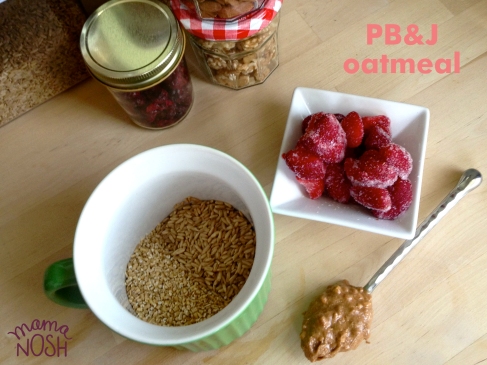It’s national peanut butter & jelly day, which makes me want to do a peanutbutterjellytime dance. PB&J sandwiches have always been a favorite, so I felt it was important to celebrate today. For dinner, I made a gooey, crunchy, sticky and sweet pb&j&banana sandwich on gluten-free bread and washed it down with a glass of ice cold milk.
But, what I was extra excited about was my PB&J breakfast. Ever since needing to increase my breast milk supply after going back to work, I eat oatmeal for breakfast every morning. Oats are a well-known lactogenic food (galactogogue) and provide iron, vitamins, minerals, dietary fiber, and give a fullness that busy breastfeeding Mamas need. Whole oat groats are the least processed and most nutritious, steel cut oats are next best and then rolled oats. The instant or quick oats have been steamed and processed and likely contain other ingredients you don’t want. They’ve lost a lot of their nutritional value and usually taste gluey.
Plus, there’s something about a really hearty bowl of oats that I’ve made the night before and can enjoy in the morning – it’s like my cup of coffee (not in the wake-me-up way, but more the warm-me-up-with-a-big-ole-mug way).

It’s become such an important part of my day that I turned part of our kitchen nook into my oatmeal corner. Then, everything I need is easily accessible so I can make my oatmeal the night before and even do it with one hand (baby in the other) if needed. Why at night you ask? Oat groats and steel cut oats need to be soaked before they can be eaten. (they verge on the crunchy side if not), so I let them hang out overnight. Lots of people think steel cut oats are a pain, but they’re not! I just put all my oatmeal ingredients in a bowl, cover them with water from the tap, put a lid on and they’re ready to be heated and eaten in the morning.
To make it even easier, I bought this durable green Corningware mug with a spill-proof lid. It was less than $10 and well worth the investment. In the morning, I throw it in my purse/diaper bag/suitcase and warm it up at work. It’s so easy.
I can definitely tell a difference in my milk supply on the days that I do and don’t eat oatmeal. Eating oatmeal means more milk to pump!

PB&J Oatmeal:
1/4 C oat groats
1/4 C thick rolled or steel cut oats
1 heaping tablespoon peanut butter (I like crunchy)
1 handful strawberries or raspberries
1 cup water
1/2 t vanilla, brown sugar, maple syrup or coconut sap sugar optional
1 t ground flaxseed or chia seeds optional
Splash of milk (almond, soy, hemp, goat, cow, whichever you like)
Dump all the ingredients in a bowl 1 or 2 nights before. Cover with a lid and keep in the fridge until you’re ready to eat. Add more water if needed and heat in the microwave for 90 seconds. Then you’re ready for peanutbutterjellytime.
Happy noshing!


